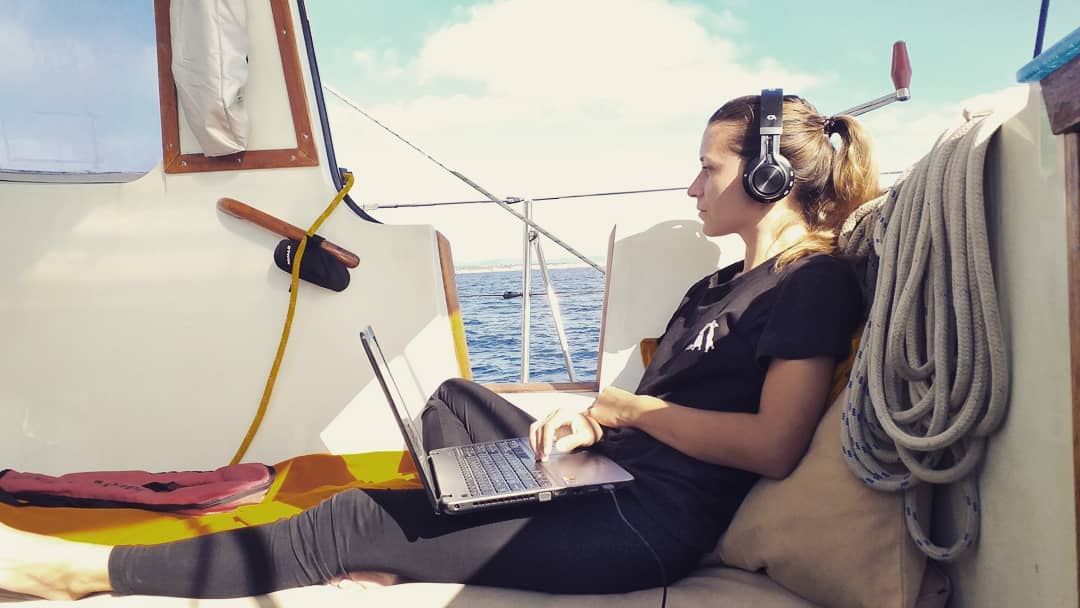Sunshine, a sandy beach, a straw hat and a logged-in Teams platform—we first associate the exotic setting with a holiday, but for some, it is an everyday working environment. We tend to associate digital nomadism with smiling, cocktail-sipping and laptop-surfing people by the pool, but it is a more complex, intense and diverse lifestyle that can be traced back to the boom in digitalization, cultural modernization and the dominant emergence of the online world. This might sound a little strange at first, because who wouldn’t have daydreamed of something similar on a rainy morning in the office?
In the last Hype Lab article of the DIALOG thematic month, we present the main features of this interesting digital lifestyle, which show the enigmatic connection between humanity and digitization.
Also known from the On The Spot Smart World series, the digital world is widespread anywhere in the world: monks in Nepal who use social media, Wi-Fi hiding in underdeveloped slums and the luxury retreats in the middle of the oceans guarantee the quality presence of the digital world, or the absence of it. But can a person be present with such flexibility and adapt to their environment as digital technology? What happens when the tide turns and the fixed rhythm of life is interrupted, and sometimes we leave social connections behind and embark on a journey that provides a completely different, freer environment for working? How does technology create mental and material security? The delicate boundary between the digital world and reality creates opportunities we have not yet encountered in civilization: we can be in “more” places at once, we are in constant contact with different parts of the world, and the only question is how one can emotionally catch up with this intensity—or just be quiet to reconnect at the touch of a button at any time.
Digital nomads: wandering adventurers or conscious workers?
At first glance, digital nomads may seem like a paradox, or at least it may have seemed until decades ago when we were still watching the mysteries of dial-up Internet through monitors that looked like a “giant box.” Since then, however, the Internet, electronic devices and the way they are used have changed on a fast scale, so it is no longer surprising that the world wide web is available every day in even unreasonable places. But in order to interpret this unusual word pairing, we must first clarify who the digital nomads are—do not immediately imagine a Caucasian tribe using a mobile phone, no matter how captivating it may seem. A digital nomad is a person whose work is independent of place, so he or she does not work from an office or home, but is constantly migrating between cities, countries, or continents. They usually run a self-employed business or work remotely as an employee, but today there are also digital nomads who process their own travels to create some kind of online product, usually videos, to provide the financial backing for the trip. The point is that their main work tool is a laptop, which allows them to work from anywhere. Some digital nomads spend months in the same city working in cafés or coworking offices while living in a hotel or in houses specifically reserved for digital nomads, or are constantly on the road and living in caravans or even boats designed for this lifestyle. It provides an infinite sense of freedom at the same time, but in the meantime, a digital presence is an essential accessory in their everyday lives.
The already mentioned evolving technology had a booming effect on the development of this form of work, but even before the rapid pace of change, there were adventurous people who set off to see the world without stopping to work. In 1983, ten years before the world wide web became widespread, Steve Roberts decided to turn his recumbent bike into a mobile office. The idea was to simply keep in touch with customers and publishers while traveling full-time, and making his physical location less and less relevant. He drew his idea from the thought that despite working as a freelance journalist, he is tied to his desk. It was the dawn of digital nomadism, as he has traveled many journeys successfully with this method, constantly refining its tools.

The overwhelming success of the technological revolution later led to several similar expeditions, reinforced by the development of telecommunications or remote devices such as Paypal (1998), Skype (2003) or Airbnb (2008), which made the lives of digital nomads quite easy. In 2007, an American entrepreneur and writer Tim Ferriss wrote the New York Times bestseller, “The 4-Hour Workweek” lifestyle book, by which the idea of the digital nomad (or place independence) reached a much wider audience. The book has sold more than 1.3 million copies and has drawn the attention of countless readers to the realization of the nomadic dream. In the meantime, nomadic bloggers and, more recently, vloggers have appeared—a true reflection of the digital change. The rudimentary history of technomads from the age of primitive computer and communication technologies has grown so far that even today a government decree has been initiated in Hungary regarding digital nomads, and sometimes there are thoughts that this is the future of workers.
Digital nomadism as the main option for working in the future?
Everything has been constantly changing since the pandemic, and this happens to be the case with jobs. After the outbreak, most of us were forced into a lifestyle that included digital presence—be it education, work or even friendly conversations, essentially, it is the same rhythm as a digital nomad outside of a stable home. Now, however, in the post-pandemic reality, more and more people are switching to a digital nomadic lifestyle. Globally, the rise of a large new group of traveling, remote workers is one of the dominant narratives in the world of work reformed by Covid-19.

According to a study by the BBC, the digital nomad population in the United States grew by 50% in mid-2020 from 7.3 million to 10.9 million compared to 2019. Expert opinions suggest there will be definitely more digital nomads in certain industries after the pandemic, however, they add that a huge shift towards digital nomadism globally is unlikely and could not happen.

However, data examining workers’ preferences since the epidemic coincide with an increased interest in a digitally nomadic lifestyle. Surveys around the world have shown that most workers want to continue working remotely in some way—whether at home, in a beachfront bungalow, on a farm, or even in a completely different country.
Digital nomadism in practice: the diverse harmony of man, nature and digitization
Réka and her partner have been living as digital nomads for four years now on a sailing ship they have renovated themselves. The goal has been to orbit the Earth in at least three years, which is not what actually happened, since time takes on a completely different meaning in such a lifestyle. Before being a digital nomad, Réka had an office job in Budapest, and was educated throughout her life about the importance of studying and working, so her environment was surprised when they announced that they were entering digital nomadism. A question followed by a question—“What will you do? How will you get to work?”, The answer was simple (and in hindsight predictable)—from home!


Réka is currently working remotely for an American company, which determines the rhythm of her everyday life, but this is not her main driving force. In the beginning, it was a little interesting to grab the laptop in the seaside milieu, but today it is completely automatic: she starts the day, works, looks around the city, does her work around the boat and then works again. The interpretation of the online space is constantly changing, as she is torn from a setting full of social expectations, but she feels she makes up for the lack of gatherings of friends from here. Furthermore, this form of life gave her a different perspective, her worldview was shaped, and she put it this way, “freedom gave me the opportunity to see society from a helicopter perspective.”

There is a firm point in their lives, the ship, which provides a full sense of home. Depending on the characteristics of the sailing ship, they plan their route according to the weather: “We are going where the wind takes us, literally! Usually, the main winds control our path.”
Of course, freedom does not mean that they are completely independent of everything, as the mainstay of the digital nomadic way of life is the provision of modern technical means. On the sailboat, electricity is provided by solar panels, and buying mobile data and a SIM card is pretty much the first thing they do when they arrive in a new country—plus it’s their constant monthly spend in total. Mobile data is a great help to them, although it is most effective when they are close to shore. One of the unavoidable things of being a sailor is high humidity, so humid air can quickly ruin their electrical gadgets, thus they are very careful about this and electrical safety charts.




Thanks to the nomadic lifestyle, no matter if you work every day in front of a computer, you will be part of a different culture. It helps a lot in problem-solving and personality development. Digital nomadism is, in fact, a rather complex and profound thing, because in addition to being a professional challenge, it results in very serious mental development, and it also conveys a sensitive symbiosis of man, nature and technology.

Some are rebuilding their own journey into the world of social media, so you can even see for yourself how a digital nomad lives:
Sailing around the Earth | Instagram
Sources: BBC, Microship, Denizatm
Photos: Digital Nomad Community, Paragrapshekvetili, She is the lost girl

Architectural illustrations beyond renders

Not just a background noise | The Hype&Hyper team's favorite podcasts










